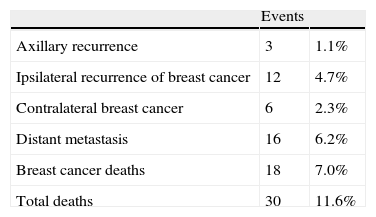The sentinel lymph node (SLN) biopsy is currently the procedure of choice for axillary node staging in initial stages of breast cancer. The purpose of this study is to establish our false negative rate within a 5-year follow-up period in 258 patients with breast cancer staged with this procedure.
MethodsA retrospective study on 258 consecutive T1–T2<3cm pN0 staged breast carcinomas treated from January 1, 2001 to December 31, 2005 was performed. The combined technique of isotope plus blue dye was used for detection. The subjects underwent a minimum follow-up of 5 years, mean 81 months, with an end of follow-up at December 31, 2010. Evidence of axillary recurrence, tumor recurrence in the breast and signs of disease progression or death were the events collected and analyzed.
ResultsOf the 258 patients, 3 false negatives (1.1%) with axillary recurrence were detected at 10, 11 and 29 months of the surgery. This did not have a significant repercussion in the survival analysis on the contrary to the existence of breast recurrence or the appearance of distant metastasis in 4.7% and 6.2% patients, respectively. Global survival related with the cancer was 93.0 (240/258) and disease free survival was 89.1% (230/258).
ConclusionThe risk of developing axillary recurrence after a negative SLN without axillary node dissection is low enough to consider the SLN procedure to be the best approach for axilla staging in early breast cancer. This staging technique also makes it possible to achieve local disease control without diminishing the survival of the patients.
La biopsia selectiva del ganglio centinela (GC) es en la actualidad el procedimiento de elección en la estadificación axilar en cánceres de mama en estadios iniciales. El objetivo de este trabajo es establecer nuestra tasa de falsos negativos a lo largo de un período mínimo de 5 años de seguimiento de 258 pacientes con cáncer de mama estadificados mediante este procedimiento.
MétodoEstudio retrospectivo de 258 pacientes con cáncer de mama consecutivos T1-T2<3cm estadificados como pN0 mediante GC entre enero-2001 y diciembre-2005.Se empleó la técnica combinada isotópica y colorante para la detección. Fueron sometidos a seguimiento con un período mínimo de 5 años, la media fue 81 meses, siendo el punto final del seguimiento el 31 de diciembre de 2010. La evidencia de recurrencia axilar, recidiva tumoral en la mama, presencia de enfermedad a distancia, y muerte fueron los eventos recogidos y analizados.
ResultadosDe las 258 pacientes, se detectaron 3 falsos negativos (1,1%), con recurrencia axilar a los 10, 11 y 29 meses de la cirugía. En el análisis de supervivencia este hecho no tuvo repercusión significativa, a diferencia de la existencia de recidiva mamaria o la aparición de metástasis a distancia que ocurrieron en un 4,7 y un 6,2% de las pacientes. La supervivencia global relacionada con el cáncer fue de un 93,0% (240/258) y la supervivencia libre de enfermedad del 89,1% (230/258).
ConclusiónEl riesgo de recurrencia axilar tras un ganglio centinela negativo sin vaciamiento linfático completo es lo suficientemente bajo como para considerar a este procedimiento como de elección en la estadificación axilar del cáncer de mama en estadios iniciales. Además, permite alcanzar un adecuado control local de la enfermedad sin disminuir la supervivencia de los pacientes.
Artículo

Revista Española de Medicina Nuclear e Imagen Molecular (English Edition)
Comprando el artículo el PDF del mismo podrá ser descargado
Precio 19,34 €
Comprar ahora








